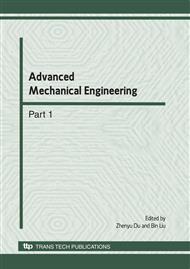[1]
R. Narayanasamy, R. Sowerby. Wrinkling of sheet metals when drawing through a conical die,. J. Mater. Process. Technol. 41(1994) 275-90.
DOI: 10.1016/0924-0136(94)90166-x
Google Scholar
[2]
R. Narayanasamy, C. Loganathan. The influence of friction on the prediction of wrinkiling of prestrained blanks when drawing through a conical die,. J. Mater & Design. 28 (2005) 904-912.
DOI: 10.1016/j.matdes.2005.10.018
Google Scholar
[3]
A.H. van den Boogaard, J. Huetink. Simulation of aluminium sheet forming at elevated temperatures. J. Comput. Methods Appl. Mech . Engg. 195 (2006) 6691-6709.
DOI: 10.1016/j.cma.2005.05.054
Google Scholar
[4]
K. Shinagawa, K. Mori, K. Osakada, Finite element simulation of deep drawing of stainless steel sheet with deformation-induced transformation, J. Mater. Process. Technol. 27 (1991) 301.
DOI: 10.1016/0924-0136(91)90059-n
Google Scholar
[5]
H. Takuda, K. Mori, T. Masachika, E. Yamazaki, Y. Watanabe. Finite element analysis of the formability of an austenitic stainless steel sheet in warn deep drawing, J. Mater. Process. Technol. 143-144 (2003) 242-248.
DOI: 10.1016/s0924-0136(03)00348-0
Google Scholar
[6]
D. Eugene oster gaard, Advanced die making (1967) p.129.
Google Scholar
[7]
G. Palumbo, L. Tricario. Numerical and experimental investigations on the warm deep drawing process of circular aluminum alloy specimens. J. Mater. Process. Technol 184 (2007) 115-123.
DOI: 10.1016/j.jmatprotec.2006.11.024
Google Scholar
[8]
Qun-Feng Chang, Da-Yong Li, Ying-Hong Peng, Xiao-Qin Zeng. Experimental and numerical study of warm deep drawing of AZ31 magnesium alloy sheet. Intl. J. Machine tools & manufacture 47 (2007) 436-443.
DOI: 10.1016/j.ijmachtools.2006.06.013
Google Scholar
[9]
Y.S. Lee, M.C. Kim, S.W. Kim, Y.N. Kwon, S.W. Choi, J.H. Lee. Experimental and analytical studies for forming limit of AZ31 alloy on warm sheet metal forming. J. Mater. Process. Technol 187 (2007) 103-107.
DOI: 10.1016/j.jmatprotec.2006.11.118
Google Scholar
[10]
ASTME, Fundamentals of tool design(1965), p.248. second printing, Prentice-Hall of India(Private) Ltd.
Google Scholar
[11]
J.P. Fan, C.Y. Tang, C.P. Tsui, L.C. Chan, T.C. Lee. 3D finite element simulation of deep drawing with damage development. Intl . J. Machine Tools & Manufacture. 46(2006) 1035-1044.
DOI: 10.1016/j.ijmachtools.2005.07.044
Google Scholar
[12]
YH. Kang, YK. Kang, JW. Park, SR. Gong. Tool temperature control to increase the deep drawability of aluminium 1050 sheet. Intl . J. Machine Tools Manufacture. 41(2001) 1283-94.
DOI: 10.1016/s0890-6955(01)00008-6
Google Scholar


